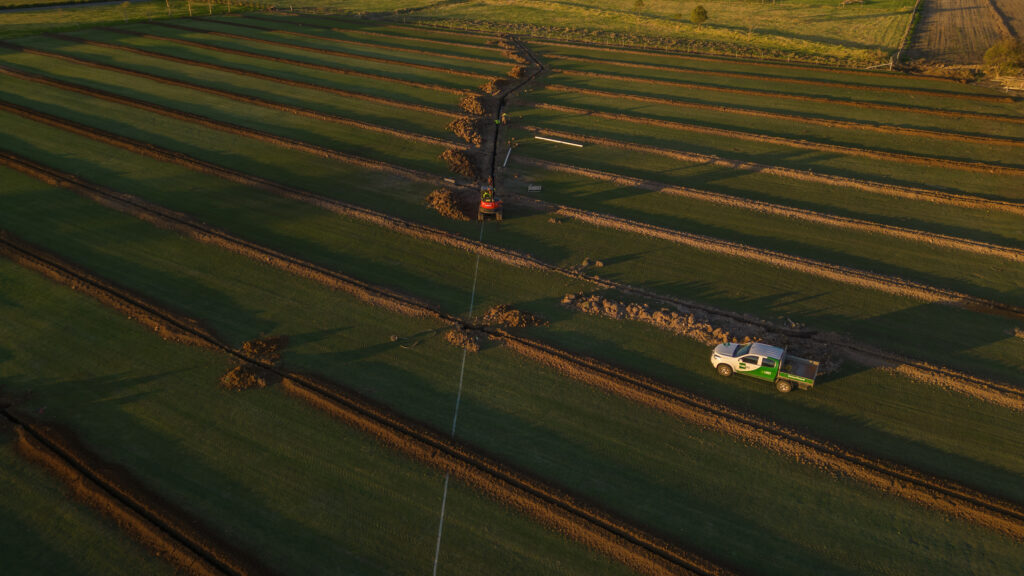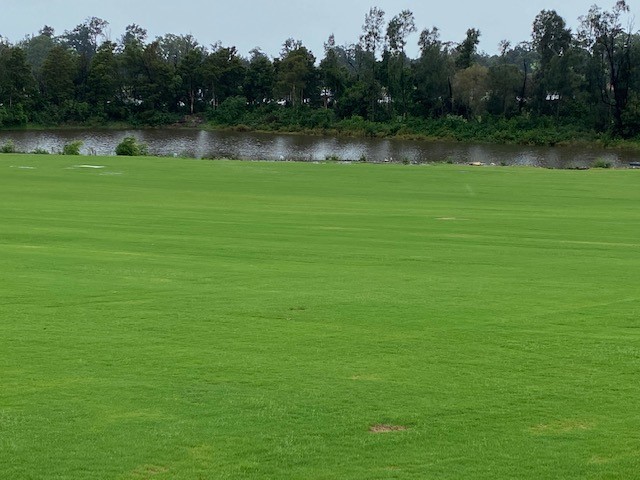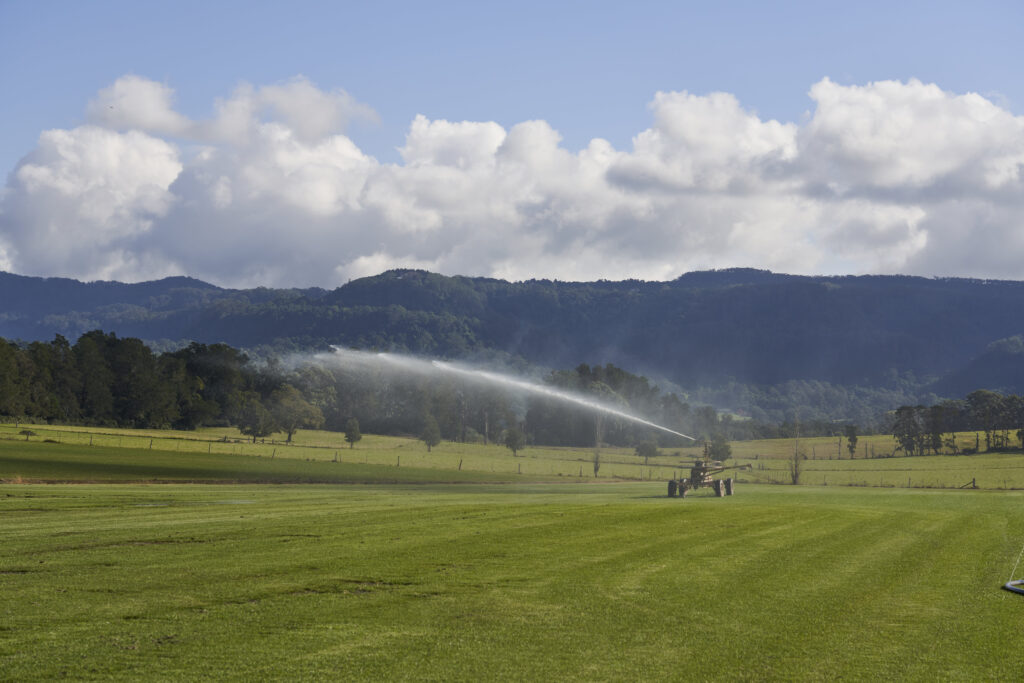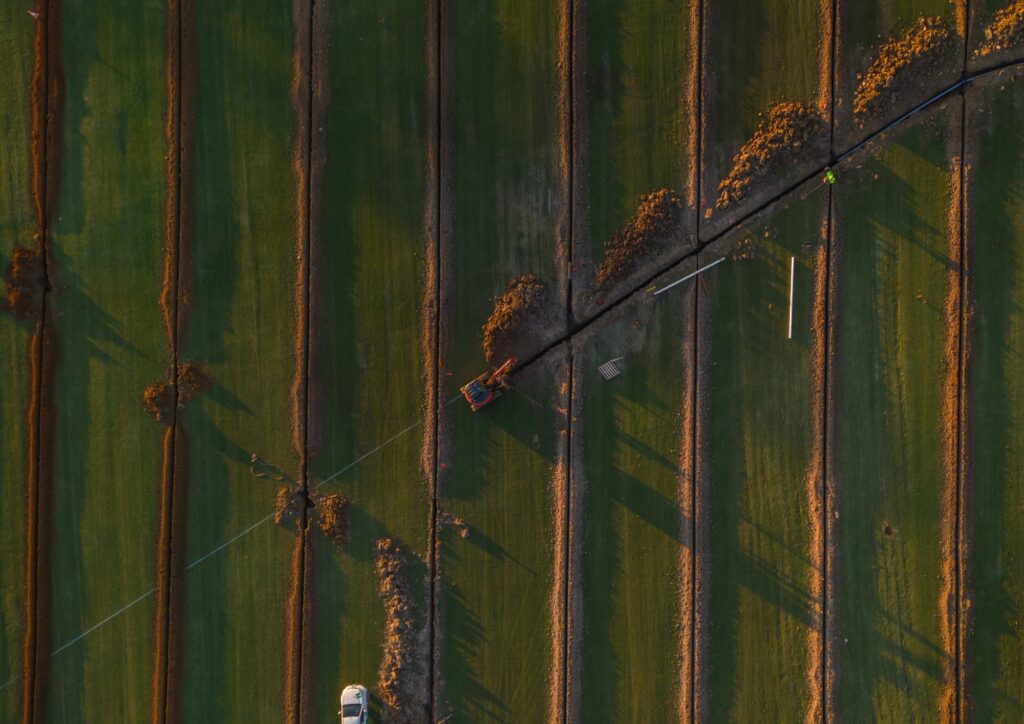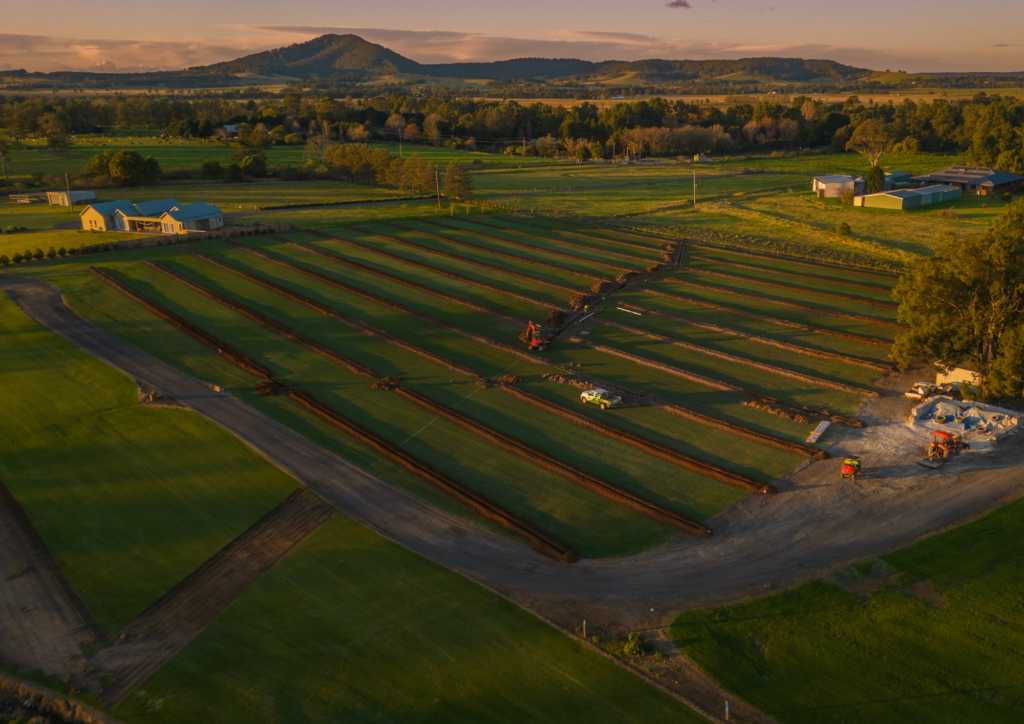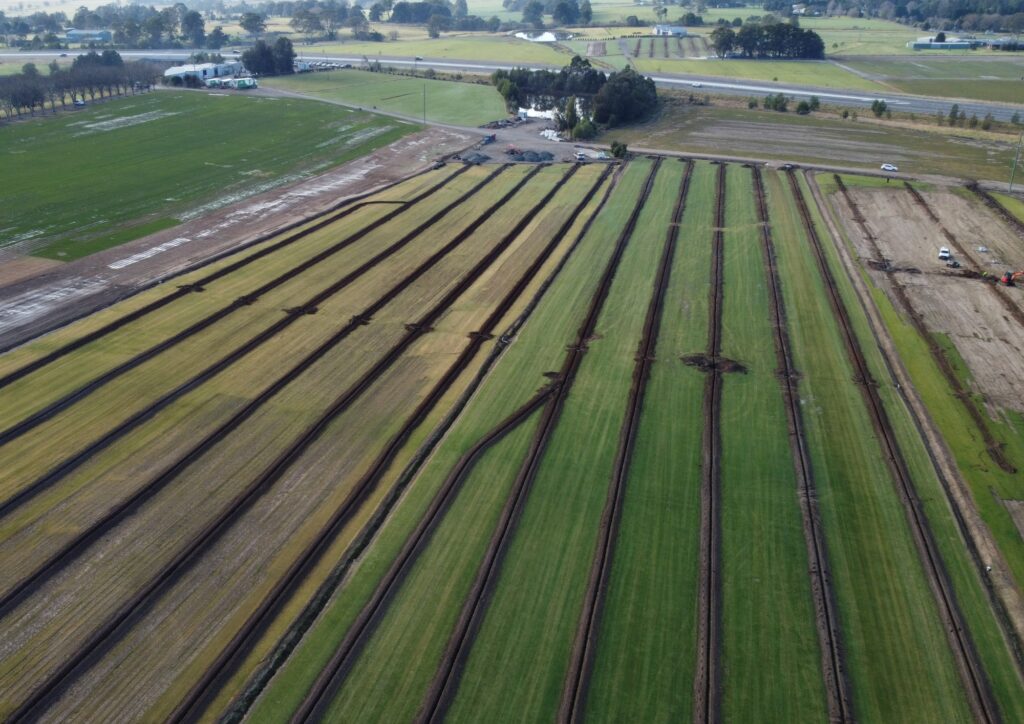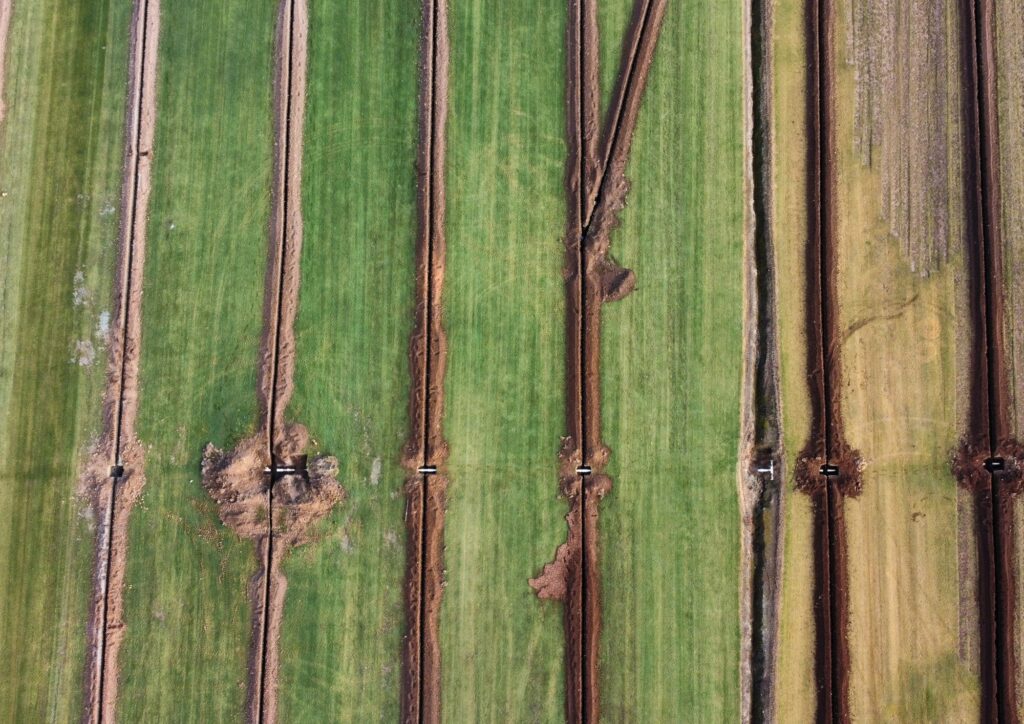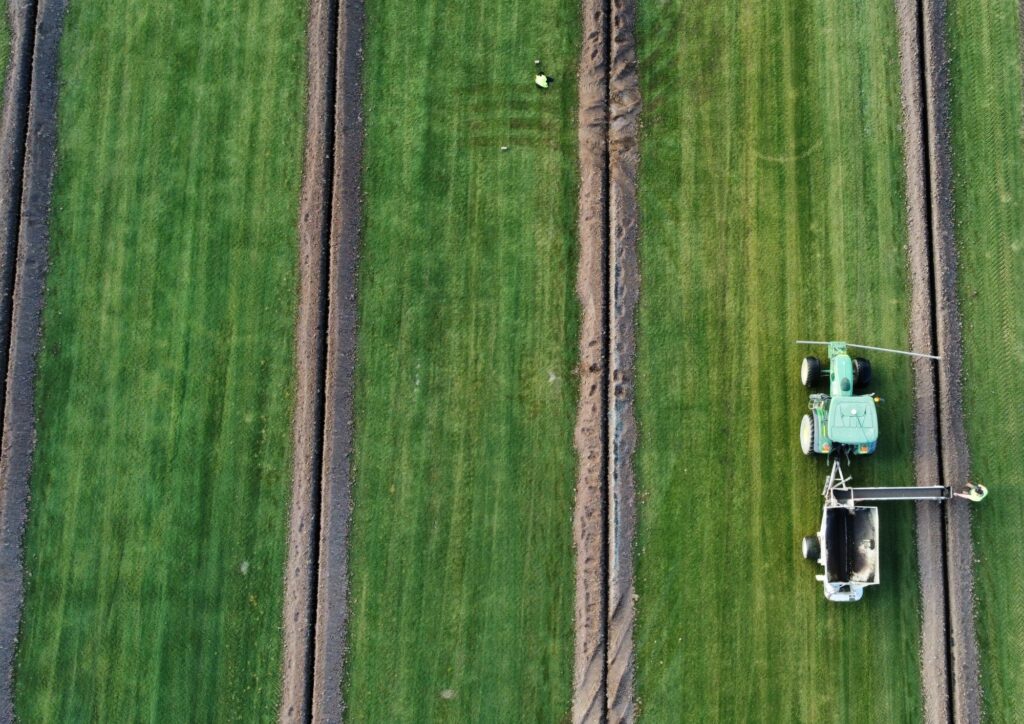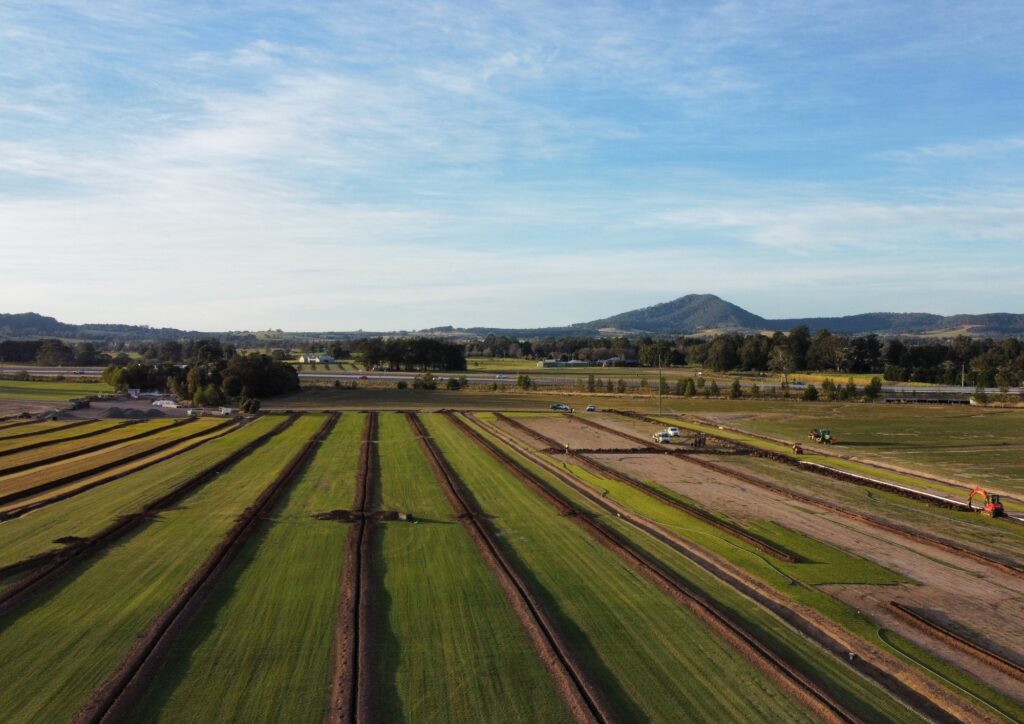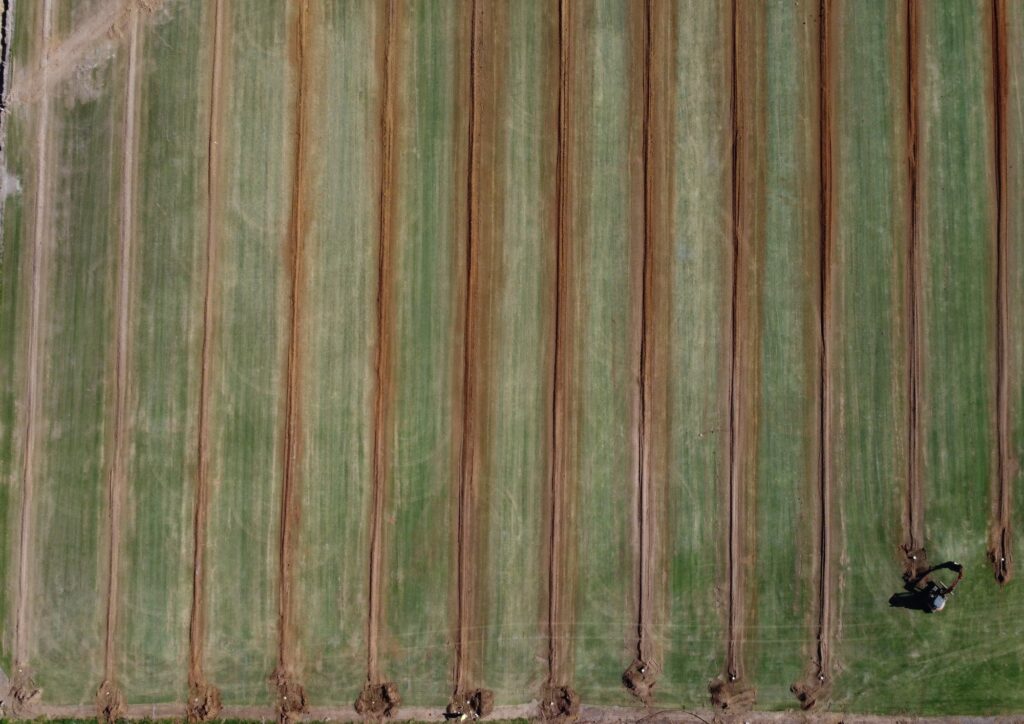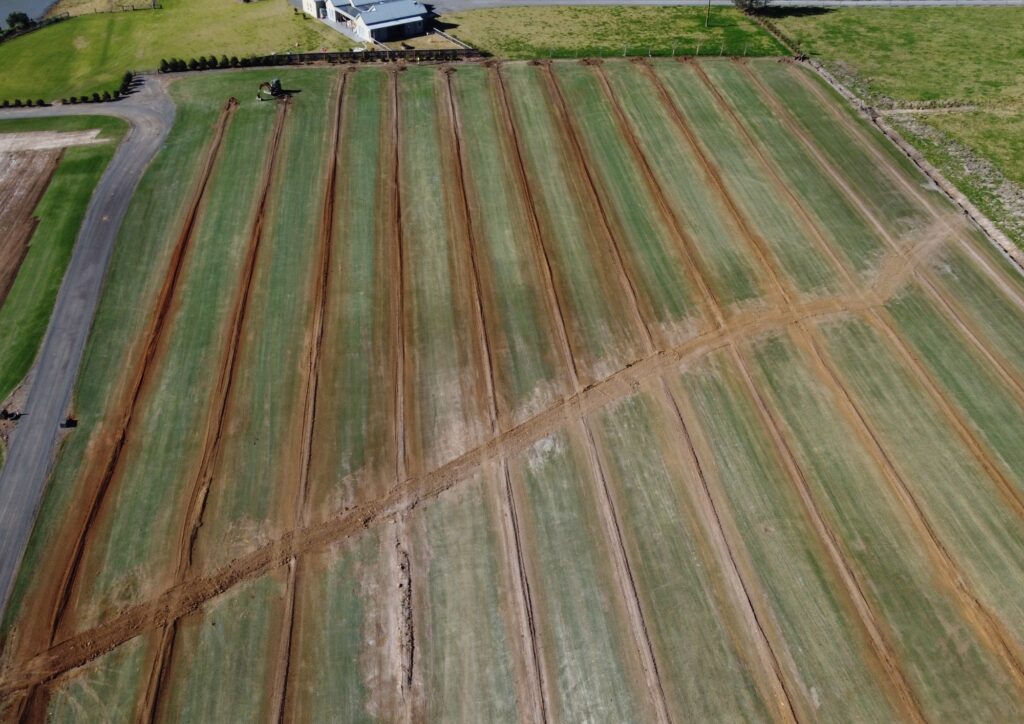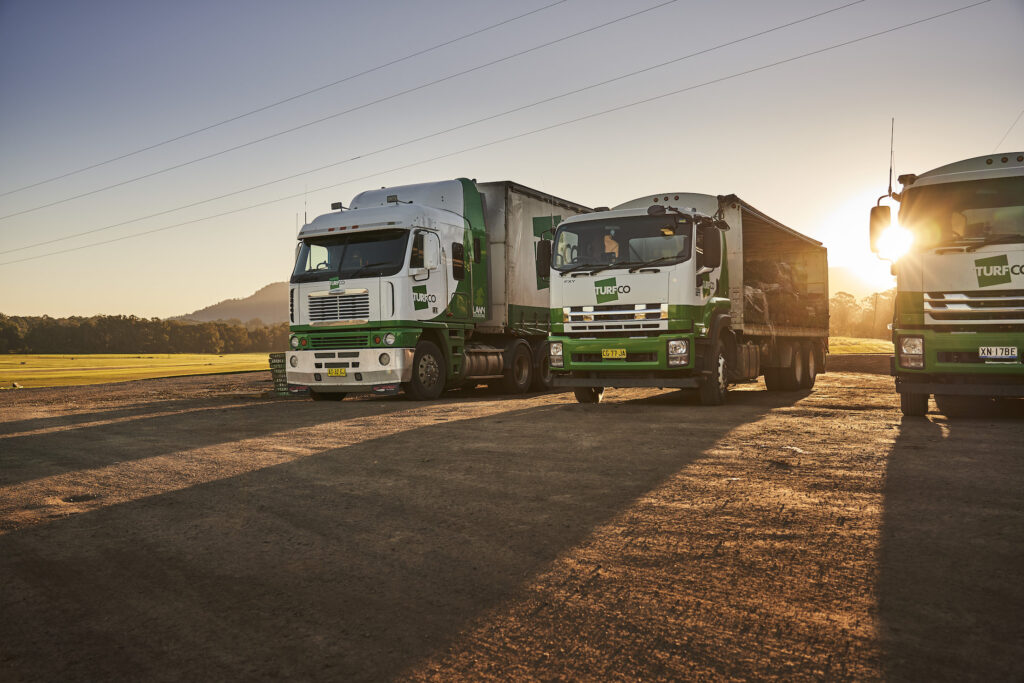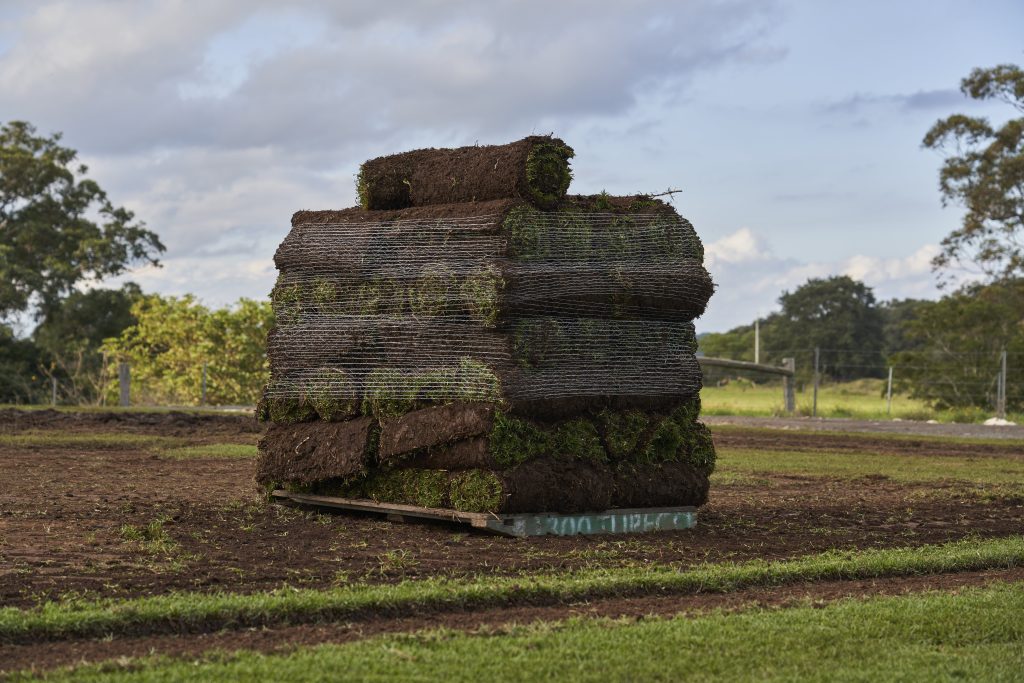Installing Ag Line Drainage at Turfco
In this article, we talk about:
Working With The NSW Rural Assistance Authority
Turfco was fortunate enough to work with the NSW Rural Assistance Authority in floodproofing our farm by implementing a sustainable system for the re-use and recycling of water. The NSW Rural Assistance Authority has decades of experience in helping producers, business operators, and regional communities become more resilient, self-reliant, and sustainable.
With the help of the NSW Rural Assistance Authority, we built a robust drainage system using Ag Lines (Agricultural Pipes).
One in a 100-Year Flood
The NSW Rural Assistance Authority was enlisted to assist our turf farm following the harsh impacts of a three-year reign of La Niña, but most notably after the wettest year on record for New South Wales in 2022 with Berry receiving approximately 3.5 metres of rainfall. To put that in perspective, the average yearly rainfall for Berry NSW is about 2 metres.
It was in October 2022 when this record-breaking year reached its peak. We were unable to harvest any turf for more than 50% of the days this month, meaning we couldn’t provide our customer base with product in the peak of demand. Being spring and peak growing season for turf, October is normally one of our busiest months of the year for us.
Our business has never seen such disruption than in the final quarter of 2022 (October-December), with 1/3 (one-third) of days without production. To convey the severity of the continued rainfall in 2022, our farm is classified as “flood-free” land due to a large portion being situated on a hill. Typically, such classification means our area is not at risk or susceptible to flooding. However, even with our promising position, the sheer amount of relentless rainfall led even our farm to see the consequences of Mother Nature’s force.
All things considered, we were able to continue production where possible, only requiring a few sequential days of dry weather before resuming harvesting.
Lower-lying farms weren’t as lucky. Turf farms in Windsor and Taree went completely underwater during this period which had devastating impacts on their farms and businesses for extended periods of time. Some of these turf farms are still suffering the impacts of these floods even today.
Our Reliance on Rainfall
Despite the frustration that comes with such force and volume of rain as seen in 2021 & 2022, rain has been and always will be our most precious resource.
We’re unlike other turf farms in that we rely heavily on natural irrigation and harvested rainfall through catchment drains on our farm which fills our dams. These dams and natural runoff allow us to re-use all the water available across our farms.
The mass amount of rainfall from 2022 was collected however, our dams quickly reached capacity. Most of our dams overflowed regularly and one even broke its banks.
Our water storage is limited with 4 small dams spread across our 3 farms / 200 acres. The total holding capacity of these dams is approximately 33 Megalitres. In comparison, other turf farms are located next to large bodies of flowing water, making irrigation almost always readily available. We would love nearly half the water of some other turf farms. Turf farms like those in the Hawkesbury region are situated next to the Hawkesbury River.
Unfortunately, Turfco isn’t situated near a large natural body of water to this scale. Although, this proximity to a mass amount of water can have its downfalls. Turf farms located next to a large river like the Hawkesbury River generally have a higher likelihood of flooding due to their low-lying position.
More so in the past 2 years than ever, we have experienced the unpredictability of rainfall, but this is the nature of the agricultural game. While a lot of elements are out of the control of most farmers, there are measures that can be implemented to ensure we succeed in the things that we can control.
Making Use of Our Dams
Our farm is on a hill with widespread surface drainage feeding into a dam. Once that dam is full, we’re able to pump water uphill through underground mainlines to a holding dam for extra storage.
When we irrigate our turf paddocks, we simply pull water from the main dam. When that dam gets low, we gravity-feed water back down from our holding dam at the top of the farm.
With such an intense number of underground springs present at our farm, there are copious amounts of groundwater sitting idle under our soils, creating paddocks that stay wet for prolonged periods of time.
Installing Ag Line drainage will serve in freeing up the wet paddocks of excess moisture while simultaneously feedback into our irrigation catchment drains.
From One Extreme to the Other
This winter, (2023) is the driest winter we’ve had since 1938 (85 years).
At Turfco, we generally wait for a predicated rainfall event to align with some of our farming practices. For example, to conserve and optimise as much water as we can, we will time our farm fertiliser applications with an upcoming rainfall event. This requires a fair amount of precision and a heavy reliance on the certainty of a weather forecast.
We will select to fertilise our paddocks if the predicted rainfall is scheduled to be anywhere between 5mm – 40mm. If beyond 40mm in a short period of time (storm conditions), we will avoid a fertiliser application as the dump of rain is likely to wash the fertiliser away before it has the chance to do its job.
The ideal condition for rainfall irrigation with fertiliser applications is 10-20mm of gentle rain.
Despite having a vast amount of rainfall in 2022, we still find ourselves in a battle with Mother Nature in 2023- albeit a much less severe battle.
Due to our dependence on harvested rain, without at least meeting the yearly average of rainfall, we can end up chasing our tails in some stages of our farming practices. So, more than ever, we need to make the most of any available water. Whether it’s a dry or a wet period, water is always our most valuable resource.
From an environmental and farm sustainability point of view, we must always be looking at the best ways to conserve and utilise this precious resource.
Implementing Systems for Water Sustainability and Flood Proofing
We have three farms located in the Berry vicinity (totalling approximately 200 acres). Our largest at 100 acres is our Jaspers Brush farm sitting at the bottom of Berry Mountain of the Shoalhaven Escarpment.
To ensure we make the most of the water we have access to and any future rain event, we have implemented a sustainable agriculture drainage system at our farm.
The first 3 weeks of July were selected to do these works for two reasons:
- It’s the middle of winter and typically the quietest three weeks of the year for us, and
- July is usually the driest month of the year in our region- even more so this July (2023).
While prolonged dry conditions can have their downfalls, the break in rainfall bred the perfect weather for this type of work.
“We weren’t worried too much about harming turf in our paddocks as if we have a window of dry weather, we need to capitalise on it. If we waited and it rained, we may not have been able to do the work for months. Some of the 800mm trenches we dug for drainage still had about 100mm of water in the bottom of them when the trenches were dug.” – Marcus Rogers, General Manager at Turfco
This labour-intensive project warranted roughly 120 hours of work by 6 staff members, give, or take. The job required the following products, equipment, and machinery:
- 7km of Ag Pipe
- Nearly 500 Tonnes of 10mm aggregate
- 5-Tonne Excavator
- 115hp Ditchwitch Trencher
- Dakota 440 Turf Tender
- 2 of our 100hp John Deere Tractors
The Process of Installing Ag Line for Improved Drainage
What are Ag Lines and their purpose?
Ag Line Pipes are underground plastic pipes that help improve drainage and reduce the risk of damage to the surface by removing water from the soil.
White-slotted UPVC pipes or black-slotted and corrugated UPVC pipes are laid in a trench which is then re-filled with permeable backfill (aggregate). Water is directed by the aggregate to the pipe and then drained away. The pipe can also be fitted with a type of sock called a geofabric filter that may help prevent pipe blockages, but some people find these to be more of a burden than a help. Blocked pipes that are unable to drain water away from a property can create waterlogged soil instead of reducing moisture, so it is important that Ag Pipes are installed correctly. We chose to use an unsocked Ag Line to ensure that there are lesser chances of restrictions on the water draining correctly.
Our Jaspers Brush farm has long had issues with underground springs and excessive misplaced underground water due to its layout and location (below the Berry Mountain Escarpment), accompanied by the naturally compacted soil. We farm on only 300-500mm of topsoil then it quickly changes to heavy clay & shale in some instances.
Some of our most elevated ground is the wettest due to these underground springs, which were affecting more than half of the total farm as underground water would leach into the soil and run down the whole hill disturbing up to 4 paddocks at a time.
Where to start?
Ag Line drainage was installed within two of our TifTuf Hybrid Bermuda paddocks (totalling 10 acres).
- We dug multiple parallel lines approximately 10m apart. The gradient of the land worked in our favour with the way the hill was shaped meaning we were able to easily run the Ag Lines west to east on a steep gradient hopefully catching a majority of the excessive runoff from the underground springs.
- We used 10mm of aggregate and an unsocked Ag Line. The aggregate helps direct water to the pipe much quicker than our farm soil while also limiting finer soil particles from blocking up the Ag Pipe.
- Aggregate in this context, is defined as permeable backfill. Permeable backfill refers to the aggregate applied to the trench above the drain, typically to the base of the topsoil.
- The use of permeable backfill is a debated subject, primarily due to the significant associated cost. Which we can certainly vouch for. The aggregate used as preamble backfill to our Ag Line drainage totalled roughly 1/3 (one-third) – ½ (half) of the cost of the entire project. Although, the importance of using aggregate in this process is priceless.
- There are many examples of old drainage systems without permeable backfill that still have some function; however, research indicates that on drained clay soils without permeable backfill, while the drains may initially function well, the permeability of the soil in the drain trench decreases with time.
- We left the aggregate 300-400mm from the top of ground level to limit disrupting the drainage system when we are cultivating and working on the paddocks. If we did not harvest turf or disturb the surface drainage material such as sand and gravel would have been closer to the surface.
- We then used our John Deere tractors to compact the remaining 300-400mm with some existing soil, restoring the levels of our paddocks to the level they were prior to when the works began. Thus, ensuring we can soon seamlessly resume harvesting these paddocks. With a small amount of time, our turf paddocks will eventually grow over and cover these soil lines left behind by our drainage work: completely invisible from the surface.
O’Keffees Farm
The same was done at our Jaspers Brush farm on the eastern side of the Princes Highway, better known at Turfco as O’Keffees Farm. Specifically, within our 7.5-acre TifTuf Hybrid Bermuda paddock.
This paddock is naturally a bowl-like shape where water pools in the centre, providing no benefit or ability to use this water as it idly sits in the middle of the paddock.
To rectify this issue, we dug 700mm deep trenches 10m apart going east-west on the paddock following ground level with 100mm Ag Drain coil filled with 400mm of 10mm aggregate.
The middle of the paddock is the lowest point and we needed to remove the excess water laying there. We did so by installing 150mm solid PVC pipes with slots to catch all the water, this runs for over 100m to our dam to help aid in reusing water.
These pipes are used to improve subsoil draining by removing/funnelling the excess water into a nearby dam where we can then harness this water and re-use it for our farm irrigation (sustainably and cost-effective farming).
“This paddock is both low lying limiting water’s ability to run off and filled with underground springs. We installed the drainage to remove the low-lying water and by running the pipes 10m apart along the whole paddock we are hopeful of tapping into the system of underground springs to remove the excessive water. In the wet periods of 2021 & 2022, there were sections of this paddock that could not be mown for 3 months due to the springs and low-lying water.” – Marcus Rogers, General Manager at Turfco
A large focus of this project is the efficiency of the paddocks and resources. These are paddocks that have harvested poorly in the past, stayed wet for prolonged periods of time and once dry went hard as a rock.
Whilst water is great, excessive water speeds up ground compaction, so these paddocks were either too wet or too dry. This drainage solution fixes the too-wet issue whilst harvesting the wasted groundwater in the process.
We are then essentially putting the water back on the paddock that we drained out, but we are applying the re-used water efficiently at times when the turf needs it, as opposed to sitting under the soil causing issues.
A Sustainable Future For Turfco
As we approach the beginning of August and the final month of the driest winter in 85 years, we continue our hopes for any amount of rainfall. Not only for its benefits to our and many other agricultural businesses but to put all our hard work on a new Ag Line Drainage system to the test!
We look forward to a more sustainable, efficient, and productive future at Turfco.

